Emissions
Visualized: Per Capita Electricity Emissions, by State
The following content is sponsored by the National Public Utilities Council
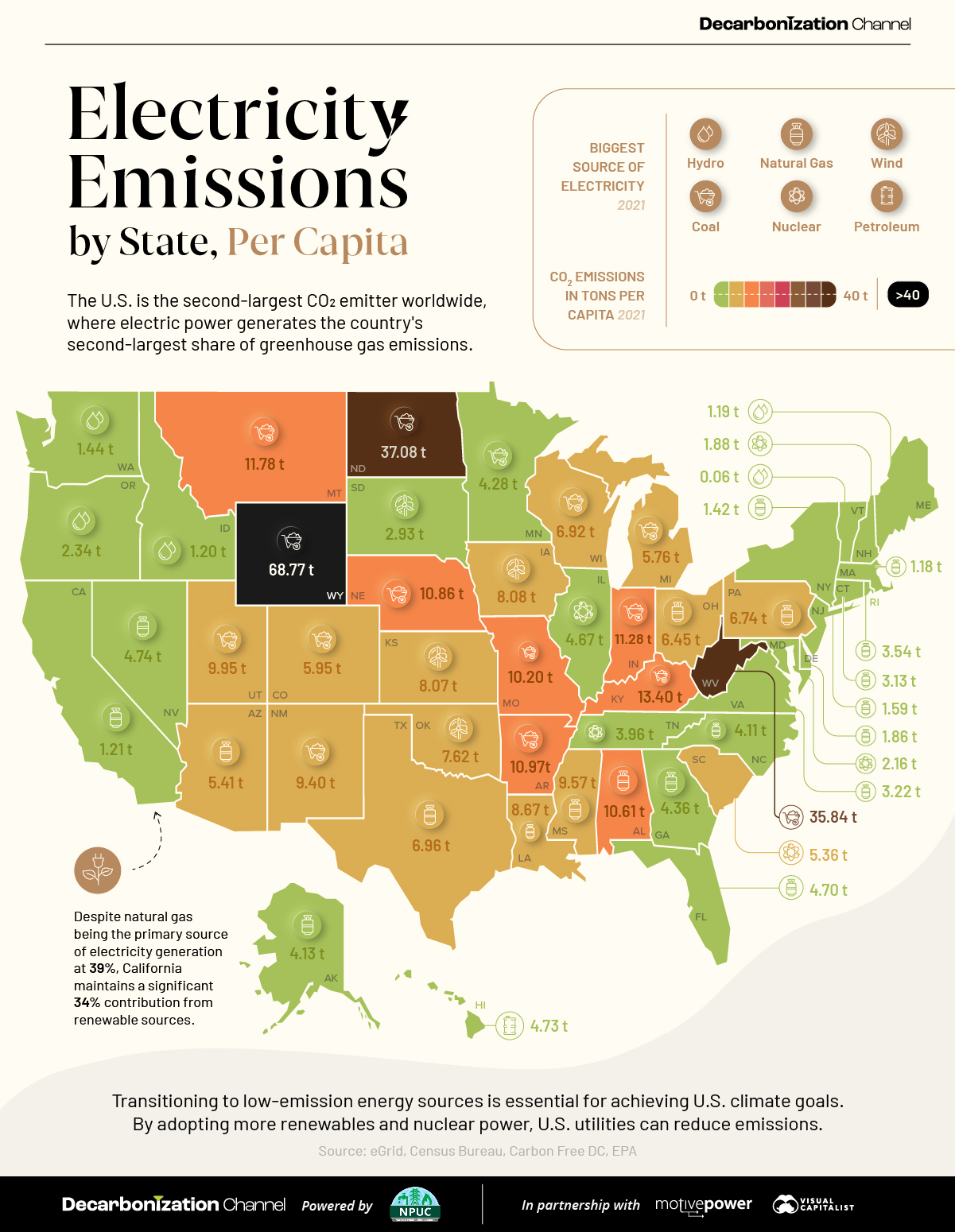
Per Capita Electricity Emissions by State
The U.S. is the second-largest CO₂ emitter worldwide, with electric power contributing significantly to the country’s greenhouse gas (GHG) emissions.
In collaboration with the National Public Utilities Council, this graphic uses data from eGrid to showcase per-capita electricity emissions by state and each state’s largest source of power.
U.S. Power Sector: Second in CO₂ Emissions
According to the Global Carbon Atlas, the top three global polluters are China, the U.S., and India—accounting for half of the world’s CO₂ emissions.
The U.S., however, leads by far in terms of CO₂ emissions per capita, with 15.3 metric tons per person, while China and India have lower rates at 7.4 and 1.9, respectively.
A substantial portion of these emissions comes from electricity generation. According to the United States Environmental Protection Agency, the electric power sector is the second-largest source of U.S. greenhouse gas emissions, contributing 25% to the total.
Examining emissions per state, Wyoming, North Dakota, and West Virginia top the list of CO₂ emissions per capita, relying primarily on coal as their source of energy.
Here is a table showing emissions by state per capita, from highest to lowest:
| State | CO2 emissions in tons per capita (2021) | Biggest Source of Electricity (2021) |
|---|---|---|
| Wyoming | 68.77 t | Coal |
| North Dakota | 37.08 t | Coal |
| West Virginia | 35.84 t | Coal |
| Kentucky | 13.40 t | Coal |
| Montana | 11.78 t | Coal |
| Indiana | 11.28 t | Coal |
| Arkansas | 10.97 t | Coal |
| Nebraska | 10.87 t | Coal |
| Alabama | 10.61 t | Natural Gas |
| Missouri | 10.20 t | Coal |
| Utah | 9.95 t | Coal |
| Mississippi | 9.57 t | Natural Gas |
| New Mexico | 9.40 t | Coal |
| Louisiana | 8.67 t | Natural Gas |
| Iowa | 8.08 t | Wind |
| Kansas | 8.07 t | Wind |
| Oklahoma | 7.62 t | Wind |
| Texas | 6.96 t | Natural Gas |
| Wisconsin | 6.92 t | Coal |
| Pennsylvania | 6.74 t | Natural Gas |
| Ohio | 6.45 t | Natural Gas |
| Colorado | 5.95 t | Coal |
| Michigan | 5.76 t | Coal |
| Arizona | 5.41 t | Natural Gas |
| South Carolina | 5.36 t | Nuclear |
| Nevada | 4.74 t | Natural Gas |
| Hawaii | 4.73 t | Petroleum |
| Florida | 4.70 t | Natural Gas |
| Illinois | 4.67 t | Nuclear |
| Georgia | 4.36 t | Natural Gas |
| Minnesota | 4.28 t | Coal |
| Alaska | 4.13 t | Natural Gas |
| North Carolina | 4.11 t | Natural Gas |
| Tennessee | 3.96 t | Nuclear |
| Rhode Island | 3.54 t | Natural Gas |
| Virginia | 3.22 t | Natural Gas |
| Connecticut | 3.13 t | Natural Gas |
| South Dakota | 2.93 t | Wind |
| Oregon | 2.34 t | Hydro |
| Maryland | 2.16 t | Nuclear |
| New Hampshire | 1.88 t | Nuclear |
| Delaware | 1.86 t | Natural Gas |
| New Jersey | 1.59 t | Natural Gas |
| Washington | 1.44 t | Hydro |
| New York | 1.42 t | Natural Gas |
| California | 1.21 t | Natural Gas |
| Idaho | 1.20 t | Hydro |
| Maine | 1.19 t | Hydro |
| Massachusetts | 1.18 t | Natural Gas |
| District of Columbia | 0.09 t | Natural Gas |
| Vermont | 0.06 t | Hydro |
Interestingly, from the top 10 on our list, only Alabama doesn’t have coal as the main source of electricity.
Conversely, four of the 10 states with the lowest CO₂ emissions per capita rely more heavily on renewables, especially hydropower.
Two of the largest consumers, California and Texas, have natural gas as their main source of electricity, but also maintain a significant share of renewable sources, with 34% and 44%, respectively.
Although coal accounted for 59% of CO₂ emissions from the energy sector, it represented only 23% of the electricity generated in the United States. Natural gas accounted for 37% of electricity generation in 2021.
The Transition to Low-Emission Sources
The U.S. has set a goal to reach 100% carbon pollution-free electricity by 2035.
Transitioning to low-emission energy sources like hydroelectricity, biomass, wind, and solar is essential for meeting U.S. climate goals.
In addition, clean energy stands out as the most significant job creator in America’s energy sector, with over 3 million Americans employed in clean energy jobs during 2021.
By embracing more renewables and nuclear power, U.S. utilities can reduce emissions and contribute to economic development.
Click here to learn more about how electric utilities and the power sector can lead on the path toward decarbonization.
Emissions
Visualized: Global CO2 Emissions Through Time (1950–2022)
In this streamgraph, we break down global CO2 emissions between 1950 and 2022 using data from Berkeley Earth and Global Carbon Project.
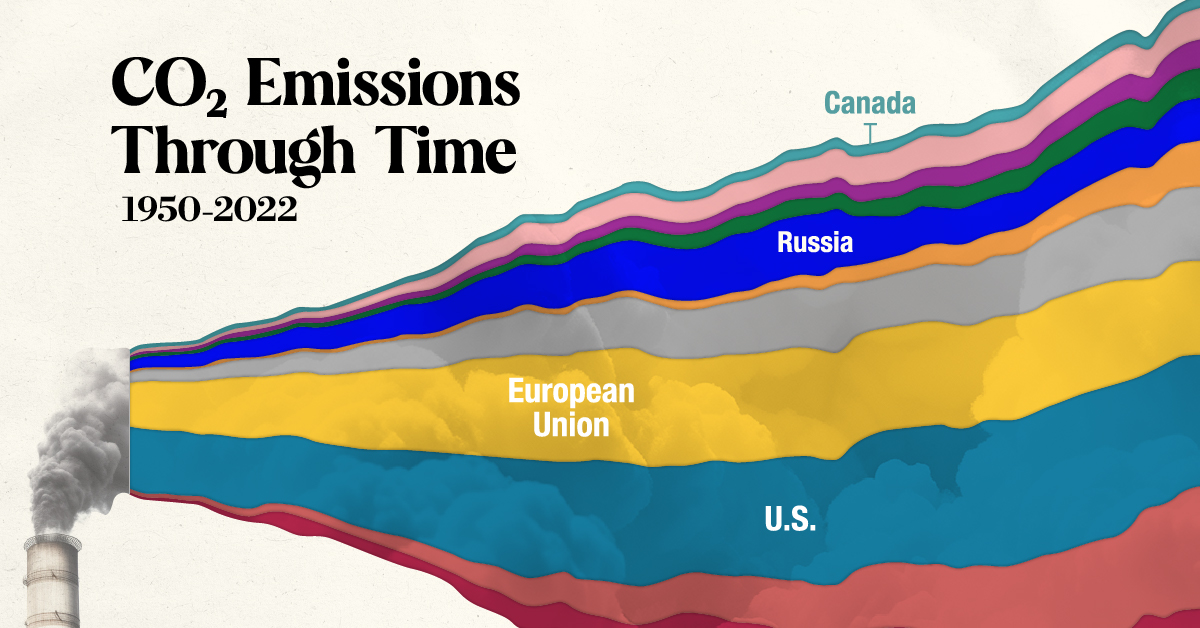
Visualized: Global CO2 Emissions Through Time (1950-2022)
Global CO2 emissions have grown six-fold since 1950.
But which countries have contributed the most to this growth?
In this streamgraph, created in partnership with the National Public Utilities Council, we answer that question using regional emissions data from Berkeley Earth and Global Carbon Project.
Global CO2 Emissions: The Last 70 Years in Review
In the 1950s, the United States and the countries that later formed the European Union (EU) were the biggest emitters in the world, responsible for over 70% of total annual emissions.
However, this trend swiftly changed as other nations entered the fray.
For instance, China’s economic surge in the 1970s, particularly with the advent of Deng Xiaoping’s new economic strategy in 1978, triggered a notable uptick in the country’s CO2 output. From 1950 to 2000, China witnessed a surge of over 4,500% in emissions, reaching an annual 3.6 billion tonnes by 2000.
Similarly, India, Japan, and the broader Asian region, all experienced emission growth exceeding 1,000% between 1950 and 2000.
| Metric tons of carbon dioxide (tCO2) | 1950 | 2000 | 2022 | Change 1950–2000 | Change 2000–2022 |
|---|---|---|---|---|---|
| China | 0.1B | 3.6B | 11.4B | 4,529% | 213% |
| Asia (excl. China, Japan, and India) | 0.2B | 3.2B | 6.2B | 1,973% | 95% |
| United States of America | 2.5B | 6.0B | 5.1B | 136% | -16% |
| European Union | 1.8B | 4.2B | 3.1B | 134% | -26% |
| Rest of World | 0.4B | 2.5B | 2.9B | 465% | 16% |
| India | 0.1B | 1.0B | 2.8B | 1,500% | 189% |
| Russia | 0.4B | 1.5B | 1.7B | 256% | 12% |
| Africa | 0.1B | 0.9B | 1.4B | 876% | 52% |
| Japan | 0.1B | 1.3B | 1.1B | 1,132% | -17% |
| South America | 0.1B | 0.8B | 1.1B | 621% | 34% |
| Canada | 0.2B | 0.6B | 0.6B | 268% | -3% |
Data note: 1950 was used as a beginning point for the graph due to the lack of available data for many countries prior to that year.
As illustrated in the table above, the growth in global carbon emissions has slowed since 2000.
With that said, global emissions have still risen from 25 billion tonnes in 2000 to 37 billion in 2022, yet another all-time high. Today, over 40% of emissions come from the United States and China, underscoring their pivotal roles in shaping the global emissions landscape.
Where Are We Headed From Here?
The United Nations’ recent Emissions Gap report highlights a concerning reality: the ongoing rate of emissions combined with existing policies steers humanity towards a world that is 3°C warmer than pre-industrial levels. This contrasts starkly with the goals of 1.5–2°C agreed to in 2015.
The Intergovernmental Panel on Climate Change projects that such a degree of warming will bring catastrophic repercussions, from severe changes in weather patterns to rising sea levels, widespread extinctions, and critical disruptions to global food and water systems.
This underscores the critical need for swift, concerted action to curb emissions and mitigate the impending environmental challenges that are potentially before us.
Learn more about how electric utilities and the power sector can lead on the path toward decarbonization here.
Decarbonization
Visualized: Carbon Pricing Initiatives in North America
We map out all of the national and subnational carbon pricing initiatives in North America using data from the World Bank.
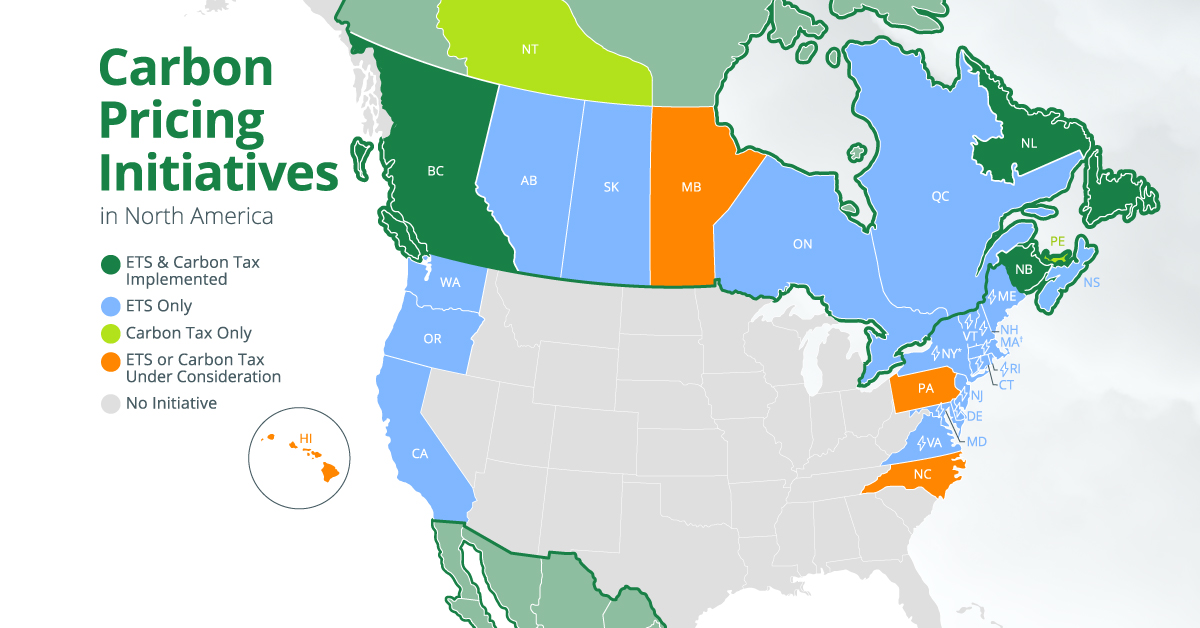
Visualized: Carbon Pricing Initiatives in North America
Carbon pricing mechanisms are a vital component of an effective emissions reduction strategy. But these initiatives currently cover just 15% of total North American carbon emissions.
To discover which initiatives are currently contributing to this coverage, this graphic sponsored by the National Public Utilities Council maps out all of the national and subnational carbon pricing initiatives across North America using data from the World Bank.
Let’s begin by looking at types of carbon pricing.
Carbon Pricing Explained
Carbon pricing is a market-based policy tool that assigns a cost to carbon emissions, incentivizing reductions through the use of economic signals.
While there are several ways to go about carbon pricing, the most commonly used types of carbon pricing strategies include:
- Emissions Trading Systems (ETS)
ETS establishes a market for trading emissions allowances among companies. A cap on total emissions is set, and all companies receive tradable emission units. Those exceeding their limits can buy allowances from those with a surplus. - Carbon Taxes
Carbon taxes impose a direct price on carbon emissions. Their goal is to disincentivize carbon-intensive activities, such as burning fossil fuels, by making them financially less attractive.
In 2022, carbon pricing strategies generated $5 billion in the U.S. and $8 billion in Canada. These funds were primarily allocated toward green investments and support for low-income households.
Carbon Pricing Initiatives By Country
The U.S. is currently the only country in North America without a national carbon pricing initiative. Both Canada and Mexico, on the other hand, have implemented federal ETS and carbon tax programs.
Beyond federal initiatives, many regions on the continent have also implemented or are considering their own carbon pricing initiatives. These subnational initiatives are listed in the table below:
| Region | Carbon Pricing Initiative | Status |
|---|---|---|
| 🇨🇦 Alberta, Canada | ETS | Implemented, 2007 |
| 🇨🇦 British Columbia, Canada | Carbon tax and ETS | Implemented, 2008 and 2016 |
| 🇨🇦 Manitoba, Canada | Carbon tax and ETS | Under Consideration |
| 🇨🇦 New Brunswick, Canada | Carbon tax and ETS | Implemented, 2020 and 2021 |
| 🇨🇦 Newfoundland and Labrador, Canada | Carbon tax and ETS | Implemented, both 2019 |
| 🇨🇦 Northwest Territories, Canada | Carbon tax | Implemented, 2019 |
| 🇨🇦 Nova Scotia, Canada | ETS | Implemented, 2019 |
| 🇨🇦 Ontario, Canada | ETS | Implemented, 2022 |
| 🇨🇦 Prince Edward Island, Canada | Carbon tax | Implemented, 2019 |
| 🇨🇦 Quebec, Canada | ETS | Implemented, 2013 |
| 🇨🇦 Saskatchewan, Canada | ETS | Implemented, 2019 |
| 🇺🇸 California, U.S.A. | ETS | Implemented, 2012 |
| 🇺🇸 Hawaii, U.S.A. | Carbon tax | Under Consideration |
| 🇺🇸 Massachusetts, U.S.A. | ETS | Implemented, 2018 |
| 🇺🇸 New York, U.S.A. | ETS | Under Consideration |
| 🇺🇸 North Carolina, U.S.A. | ETS | Under Consideration |
| 🇺🇸 Oregon, U.S.A. | ETS | Implemented, 2021 |
| 🇺🇸 Pennsylvania, U.S.A. | ETS | Under Consideration |
| 🇺🇸 Regional Greenhouse Gas Initiative (RGGI)* | ETS | Implemented, 2009 |
| 🇺🇸 Washington, U.S.A. | ETS | Implemented, 2023 |
| 🇲🇽 Durango, Mexico | Carbon tax | Implemented, 2023 |
| 🇲🇽 Guanajuato, Mexico | Carbon tax | Scheduled, 2023 |
| 🇲🇽 Jalisco, Mexico | Carbon tax | Under Consideration |
| 🇲🇽 Queretaro, Mexico | Carbon tax | Implemented, 2022 |
| 🇲🇽 State of Mexico, Mexico | Carbon tax | Implemented, 2022 |
| 🇲🇽 Yucatan, Mexico | Carbon tax | Implemented, 2022 |
| 🇲🇽 Zacatecas, Mexico | Carbon tax | Implemented, 2017 |
The RGGI was the first mandatory ETS initiative in the U.S. and applies to power plants in Connecticut, Delaware, Maine, Maryland, Massachusetts, New Hampshire, New Jersey, New York, Rhode Island, Vermont, and Virginia.
Since its inception, emissions in the RGGI region fell by more than 50%—twice as fast as the nation as a whole—and raised nearly $6 billion to invest in local communities.
Are All Carbon Pricing Initiatives Created Equal?
In the landscape of carbon pricing initiatives, one critical factor stands out—the price of carbon itself.
According to The High-Level Commission on Carbon Prices, achieving alignment between carbon pricing strategies and the Paris Agreement temperature target requires a price of US$40–80/tCO2 by 2020 and US$50–100/tCO2 by 2030.
Unfortunately, many North American initiatives fall short of these prices, especially in the U.S. and Mexico, where carbon prices reach as low as US$12/tCO2e. Conversely, most Canadian initiatives set a price of US$48/tCO2e.
It’s also important to note that the broader impact of these initiatives depends on a multitude of other factors, including the industries they cover, their flexibility in accommodating changing economic conditions, and the manner in which generated revenue is invested back into sustainable practices.
Within the balance of these various elements lies the potential to steer all industries—including the power sector—toward the necessary emissions reductions.
Learn more about how electric utilities and the power sector can lead on the path toward decarbonization here.
-
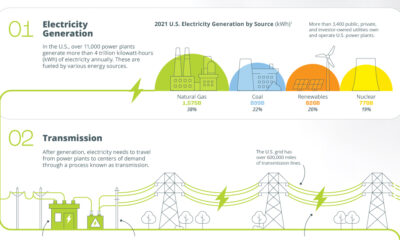
 Electrification1 year ago
Electrification1 year agoVisualized: How the Power Grid Works
-
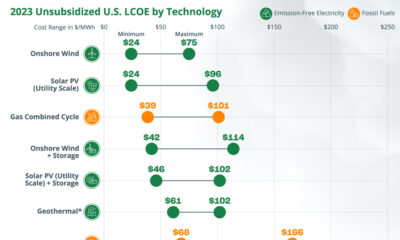
 Energy Shift9 months ago
Energy Shift9 months agoRanked: The Cheapest Sources of Electricity in the U.S.
-
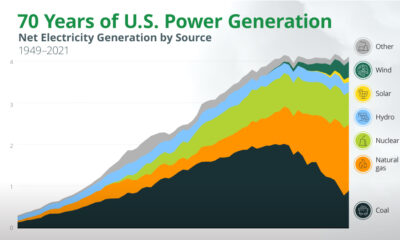
 Energy Shift1 year ago
Energy Shift1 year agoAnimated: 70 Years of U.S. Electricity Generation by Source
-
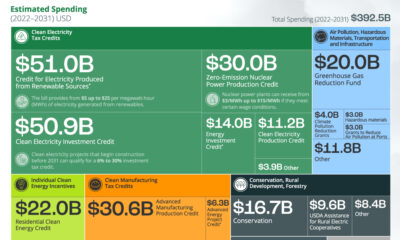
 Clean Energy1 year ago
Clean Energy1 year agoBreaking Down Clean Energy Funding in the Inflation Reduction Act
-
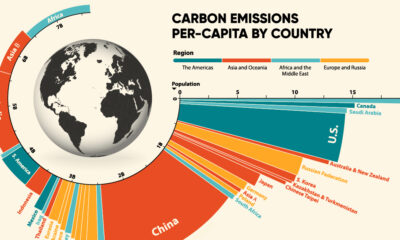
 Emissions1 year ago
Emissions1 year agoVisualizing Global Per Capita CO2 Emissions
-
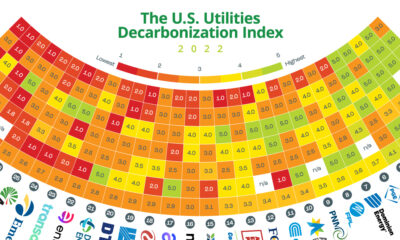
 Decarbonization1 year ago
Decarbonization1 year agoThe U.S. Utilities Decarbonization Index
-
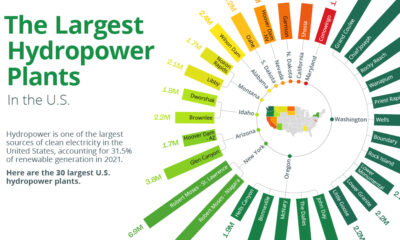
 Clean Energy1 year ago
Clean Energy1 year agoThe 30 Largest U.S. Hydropower Plants
-
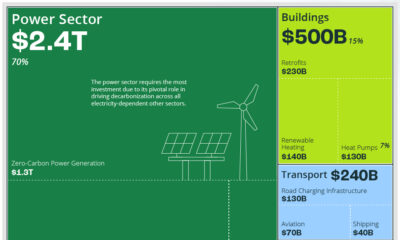
 Clean Energy7 months ago
Clean Energy7 months agoBreaking Down the $110 Trillion Cost of the Clean Energy Transition

